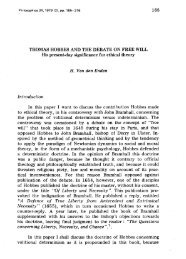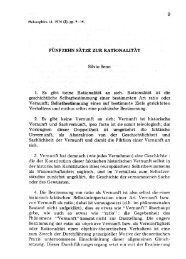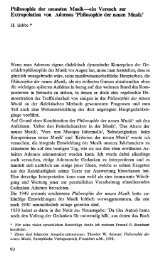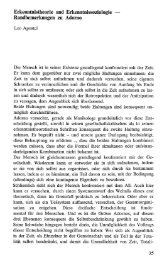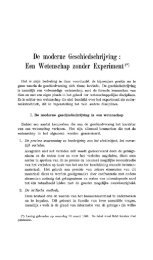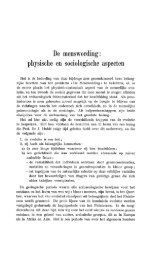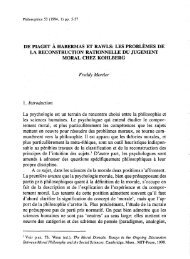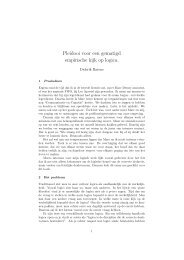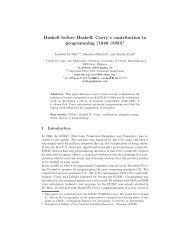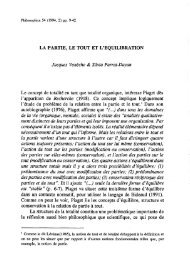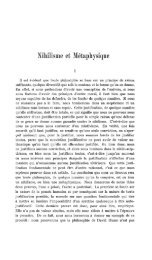CHEZ FERMAT A.D. 1637' Erkka Maula and Eero Kasanen Abstract ...
CHEZ FERMAT A.D. 1637' Erkka Maula and Eero Kasanen Abstract ...
CHEZ FERMAT A.D. 1637' Erkka Maula and Eero Kasanen Abstract ...
Create successful ePaper yourself
Turn your PDF publications into a flip-book with our unique Google optimized e-Paper software.
146 ERKKA MAULA & EERO KASANEN<br />
bounds to the ratio (p(a,k+ 1/2)-p(a,o"1» : [(p(b,k+ 1/2)-p(b,o .... 2»<br />
+ (p(c,k+l/2)-p(c,o"3»], for computations show that it increases<br />
when N increases (see Porism 2 below).<br />
It turns out, however, that a very modest lemma will suffice<br />
here.<br />
LemmB 8. If p(a,2k+l) = p(b,2k+l) + p(c,2k+l) has an integer<br />
solution a > b > c > 0, k ~ 1, then 1 > p(a,(2k+l)/2) :<br />
p(b,(2k+1)/2) + p(c,(2k+1)/2) > 1 : .[2.<br />
As for proof, if p(a,2k+l) = p(b,2k+1) + p(c,2k+1), then<br />
p(a,(2k+1)/2) = r(p(b,2k+1) + p(c,2k+1),2). The upper <strong>and</strong> lower<br />
bounds are proven indirectly. If r(p(b,2k+1) + p(c,2k+1),2) ~<br />
p(b,(2k+ 1)/2) + p(c,(2k+ 1 )/2), then p(b,(2k+ 1)/2).p(c,(2k+ 1 )/2) or<br />
the geometric mean of p(b,2k+l), c(p,2k+1) ~ 0; a contradiction<br />
because a > b > c > O. If p(b,(2k+1)/2) + p(c,(2k+1)/2) ~<br />
.[2.r(p(b,2k+1) + p(c,2k+1),2), then p(b,(2k+l)/2).p(c,(2k+1)/2) :<br />
(1/2).(p(b,2k+1)+p(c,2k+1» or the ratio of the geometric mean of<br />
p(b,2k+l), p(c,2k+1) to their arithmetical mean ~ 1; a contradiction<br />
because the geometric me an is lesser than the arithmetical<br />
mean. QED<br />
Thus the claim is proven. We can restrict ourselves to<br />
triangles w here i t is.<br />
Now, LemmB 8 actually reduces the number of such acuteangled<br />
(2k)-potent scalene triangles with integer sides, on which<br />
FLT could fail. In contradistinction to the previous Lemmas 1-6,<br />
however, LemmB 8 focuses directly on the (2k+1)th powers of<br />
a,b,c. Obviously LemmB 8 is an implication of a more general<br />
proposition. Its full potential can best be exploited by conducting<br />
the proof of Prap. 5 in such a manner that LemmB 8 serves<br />
as a necessary <strong>and</strong> sufficient condition.<br />
Where did the great mathematicians find their lemmas, then?<br />
There is one general source, the collections of propositions<br />
called porisms by the ancients. In Fermat's case, we already<br />
noted his likely contact with Diophantus' Porisms, but it is even<br />
more intimate with Euclid's. To quote Heath [7,1:435], "The great<br />
Fermat (1601-65) gave his idea of a 'porism', illustrélting it by<br />
five examples which are very interesting in themselves; but he<br />
did not succeed in connecting them with the description of<br />
Euclid's Porisms by Pappus, <strong>and</strong>, though he expressed a hope of<br />
being able w produce a complete restoration of the latter, his<br />
hope was flot realized."<br />
Ar:? Euclid 's Porisms remain 10st. even today, we must turn to<br />
the commenta tors, Pappus <strong>and</strong> Proclus. From Pappus Collection<br />
we gather that the enunciations of porisms are contracted <strong>and</strong> in<br />
fact comprehend many propositions in one enunciation [VII:648-<br />
60]. This is corroborated by his examples [7,1:432-433]. Pappus



